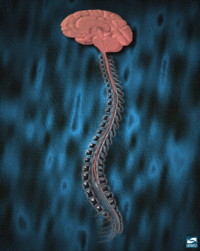The dynamics of fear and courage are all around us this winter. This season is an especially important one to attend to fear inourselves, our patients and our communities.
When fear consumes us, our kidney/adrenal system becomes braced and frozen. The K’e cycle, the Sheng cycle and our Jing are affected.
Our Bladder official communicates directly with the structures around our brainstem that initiate our fight and flight response. Hyper arousal in the brain stem can hi-jack our frontal cortex – and compromise our Shen’s capacity for thoughtful, relationship-centered decision-making. This dynamic between the brain stem and the frontal cortex is mirrored in the K’e cycle between Water and Fire. Brain stem functions mirror those of the “Sea of Marrow” and neocortex functions in turn mirror the Mind/Shen in the Classical Chinese medicine texts.
Compromised kidney/adrenal function also impacts the Liver and Gall Bladder’s job to plan and initiate action in response to threat. They can become brittle and reactive, or listless and hopeless, without the restorative power of Water supporting them.
Overwhelming fear also consumes our Jing. Trauma survivors have higher morbidity and mortality rates because of fear’s impact on the kidney/adrenal system. Winter is an important time to help replenish your patients post-natal Jing and protect their prenatal Jing.
The impact of helping a patient find curiosity, in the place of fear-informed certainty, ripples out to their families and communities. When we restore balance and regulation to the Kidney/adrenal system, we:
-
help people to stop being convinced by their chemistry;
-
interrupt their ongoing/never-ending life-threat signal;
-
enhance their capacity for self-protection, self-regulation and insight into their life-experiences;
-
build capacity for thinking about their trauma-story from a new place that includes their power and their successful negotiation; and most importantly,
-
help to restore their Supreme Controller to the center of their kingdom.
Alaine’s Two Cents
I will be spending the next year in dialogue with participants in my Restoration & Balance After Trauma Workshop series, while I write my book, tentatively titled, Restoring Balance in the Kingdom: The New Perspective on Traumatic Stress that Integrates Five Element Acupuncture with Western Neuroscience. Below is the keynote:
Experts in Eastern and Western trauma physiology, clinician-educators Alaine Duncan and Kathy Kain combine their expertise to introduce a new map for acupuncturists and other body-oriented clinicians to help restore balance in their patients. Using concepts of Acupuncture and Asian Medicine, alongside Western biobehavioral science’s description of the threat response, they describe common physical symptoms, emotional presentations, and routes for healing of five survivor “types.”
This ancient/modern integrative lens illuminates the diverse manifestations of traumatic stress in its survivors – chronic pain, autoimmune illness, insomnia, metabolic problems, and mental health disorders – and brings new hope to survivors of trauma and those who treat them.
In their first book together, Duncan and Kain provide clues to understanding and transforming the clinical and social impact of unresolved trauma in our homes, with our patients, and on the streets.
Check This Out
Dr. Daniel Keown, author of The Spark In The Machine: How the Science of Acupuncture Explains the Mysteries of Western Medicine speaks on the embryological development and importance of the Bladder Channel.
His book is an articulate, and often humorous, exploration of how the body is best understood through an integrative lens. A fascinating read, Dr. Keown’s focus is on integrative embryology and general physiology and function. I highly recommend it.
Clinical Curiosity
Where is your clinical curiosity carrying you?
Send me a question or two and I will explore them with readers in this corner next month. Here’s one that recently came to me
Q. My patient’s headache was primarily in her forehead. Was BL 2 a good choice for her?
A. It might have been. There are no universally “good” points for frontal headache pain. Use your skills in differential diagnosis to determine if this is an excess or a deficiency headache. Is there stagnation of blood or qi? An accumulation of damp or phlegm? Is there blood or qi deficiency? What meridians are impacted?
-
The most important thing in treating pain in trauma survivors is to work in a titrated way. Never needle a person who is pulling away from you! One of the many benefits of acupuncture is that we can impact symptoms from a distance through our understanding of meridian theory. You risk creating more arousal when you approach areas that are holding a tissue-memory of trauma.
Local “ah shi” points can be very helpful for headache pain, but they need to be teamed up with both pattern and constitutional diagnosis. Were you using BL 2 as an “ah shi” point?
Look for ways to integrate your patient’s acute signs into your 5 Element constitutional diagnosis with either local points on the head, or anchoring command points. Often there is a constitutionally rooted deficiency underneath the most glaring excess condition. Be sure you treat both the excess and the deficiency.

